belt Acura RSX 2002 User Guide
[x] Cancel search | Manufacturer: ACURA, Model Year: 2002, Model line: RSX, Model: Acura RSX 2002Pages: 320, PDF Size: 4.38 MB
Page 17 of 320

To reduce the chance of injury, wear
your seat belt properly, sit upright
with your back against the seat and
movetheseatawayfromthe
steering wheel to the f arthest
distance that allows you to maintain
f ull control of the car.
The National Highway Traffic Safety
Administration and Transport
Canada recommend that drivers
adjust the seat so the center of the
chest is at least 10 inches away f rom
the center of the steering wheel.
Also make sure your f ront seat
passenger moves the seat as f ar to
the rear as possible.Adjust the driver’s seat-back to a
comf ortable, upright position,
leaving ample space between your
chest and the airbag cover in the
center of the steering wheel. If you
sit too close to the steering wheel,
you could be injured if the f ront
airbag inflates.
Most shorter drivers can get f ar
enough away f rom the steering
wheel and still reach the pedals.
However, if you are concerned about
sitting too close, we recommend that
you investigate whether some type
of adaptive equipment may help.
Once your seat is adjusted correctly,
rock it back and f orth to make sure
the seat is locked in position.
See page f or how to adjust the
f ront seats. 86
Protecting Adults
Driver and Passenger Saf ety
Adjust the Seat-Backs
3.
14
Sitting too close to a front
airbag can result in serious
injury or death if the front
airbags inflate.
Always sit as far back from the
front airbags as possible.
Page 18 of 320
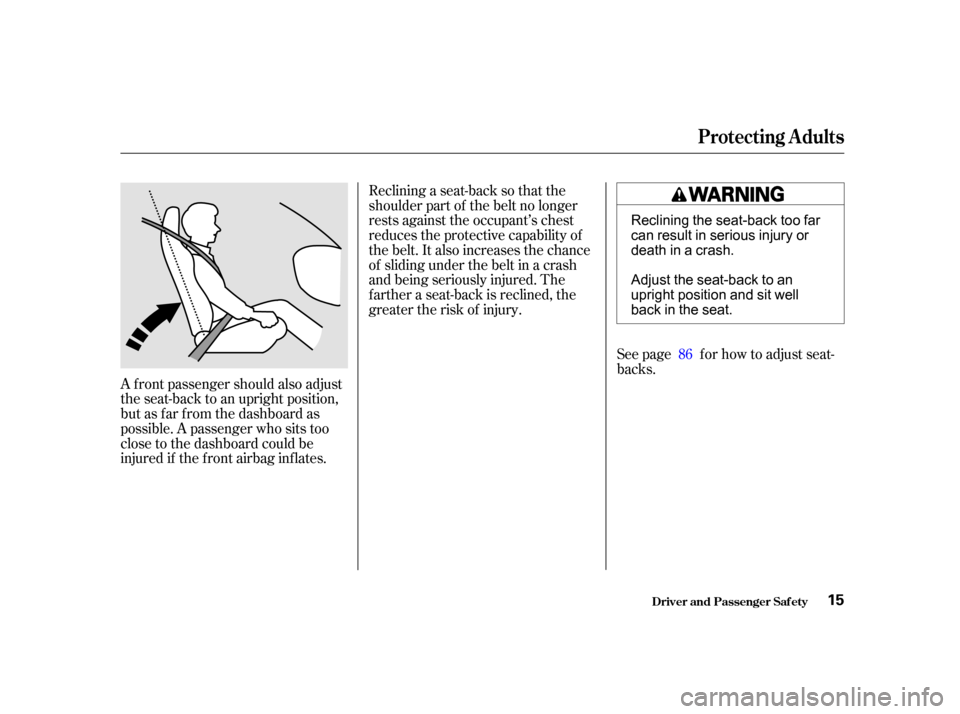
See page f or how to adjust seat-
backs.
Reclining a seat-back so that the
shoulder part of the belt no longer
rests against the occupant’s chest
reduces the protective capability of
the belt. It also increases the chance
of sliding under the belt in a crash
and being seriously injured. The
farther a seat-back is reclined, the
greater the risk of injury.
A f ront passenger should also adjust
the seat-back to an upright position,
but as f ar f rom the dashboard as
possible. A passenger who sits too
close to the dashboard could be
injured if the f ront airbag inf lates. 86
Protecting Adults
Driver and Passenger Saf ety15
Reclining the seat-back too far
can result in serious injury or
death in a crash.
Adjust the seat-back to an
upright position and sit well
back in the seat.
Page 19 of 320
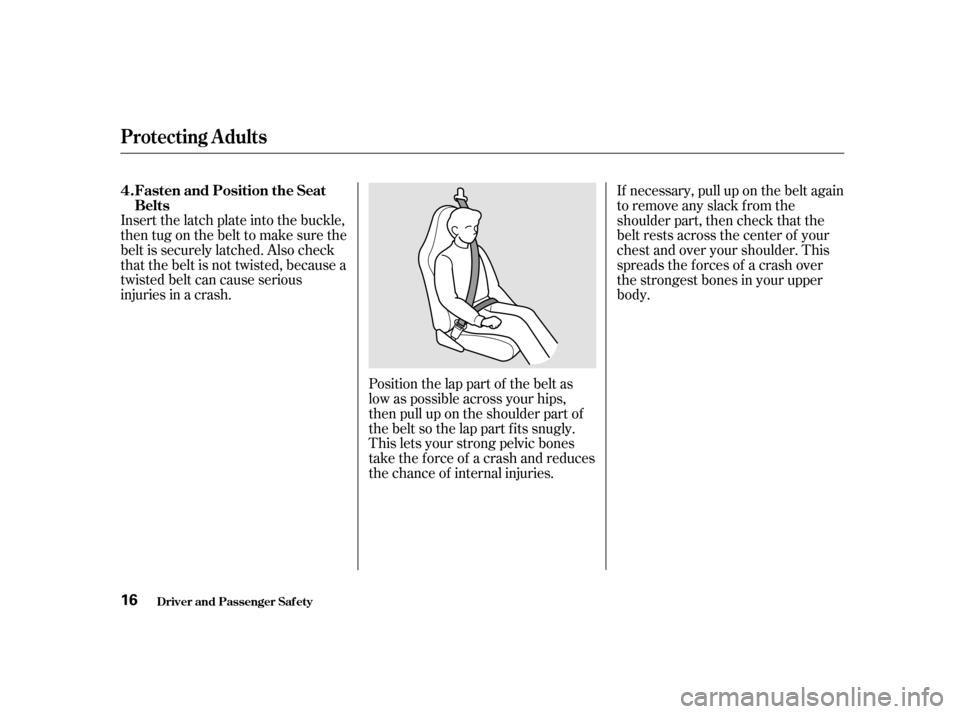
Position the lap part of the belt as
low as possible across your hips,
then pull up on the shoulder part of
the belt so the lap part f its snugly.
This lets your strong pelvic bones
take the force of a crash and reduces
the chance of internal injuries.
Insert the latch plate into the buckle,
then tug on the belt to make sure the
belt is securely latched. Also check
that the belt is not twisted, because a
twisted belt can cause serious
injuries in a crash.
If necessary, pull up on the belt again
to remove any slack from the
shoulder part, then check that the
belt rests across the center of your
chest and over your shoulder. This
spreads the f orces of a crash over
the strongest bones in your upper
body.
Fasten and Position the Seat
Belts
4.
Protecting Adults
Driver and Passenger Saf ety16
Page 20 of 320

Adjust the steering wheel, if needed,
so that the wheel points toward your
chest, not toward your f ace.
Pointing the steering wheel toward
your chest provides optimal
protection f rom the airbag.
See page f or how to adjust the
steering wheel.
See page f or additional
inf ormation about your seat belt
system and how to take care of your
belts. This could cause
very serious injuries in a crash.
If a seat belt does not seem to work
as it should, it may not protect the
occupant in a crash.
Anyone using a seat belt that is
not working properly can be
seriously injured or killed. Have your
Acura dealer check the belt as soon
as possible.
44
74
A djust the Steering Wheel
5.
Protecting Adults
Driver and Passenger Saf ety
Never place t he shoulder port ion of a
lap/shoulder belt under your arm orbehind your back.
No one should
sit in a seat wit h an inoperat ive seat belt.
17
Improperly positioning the seat
belts can cause serious injury
or death in a crash.
Make sure all seat belts are
properly positioned before
driving.
Page 21 of 320

After all occupants have adjusted
their seats and put on seat belts, it is
very important that they continue to
sit upright, well back in their seats,
with their feet on the floor, until the
car is parked and the engine is of f .Sitting improperly can increase the
chance of injury during a crash. For
example, if an occupant slouches,
lies down, turns sideways, sits
forward, leans forward or sideways,
or puts one or both f eet up, the
chance of injury during a crash is
greatly increased.
In addition, an occupant who is out of
position in the f ront seat can be
seriously or f atally injured by
striking interior parts of the car, or
by being struck by an inf lating f ront
airbag. Being struck by an inflating
side airbag can result in possibly
serious injuries.
Remember, to get the best
protection f rom your car’s airbags
and other safety features, you must
sit properly and wear your seat belt
properly.
Maintain a Proper Sitting
Position
6.
Protecting Adults
Driver and Passenger Saf ety18
Sitting improperly or out of
position can result in serious
injury or death in a crash.
Always sit upright, well back in
the seat, with your feet on the
floor.
Page 22 of 320
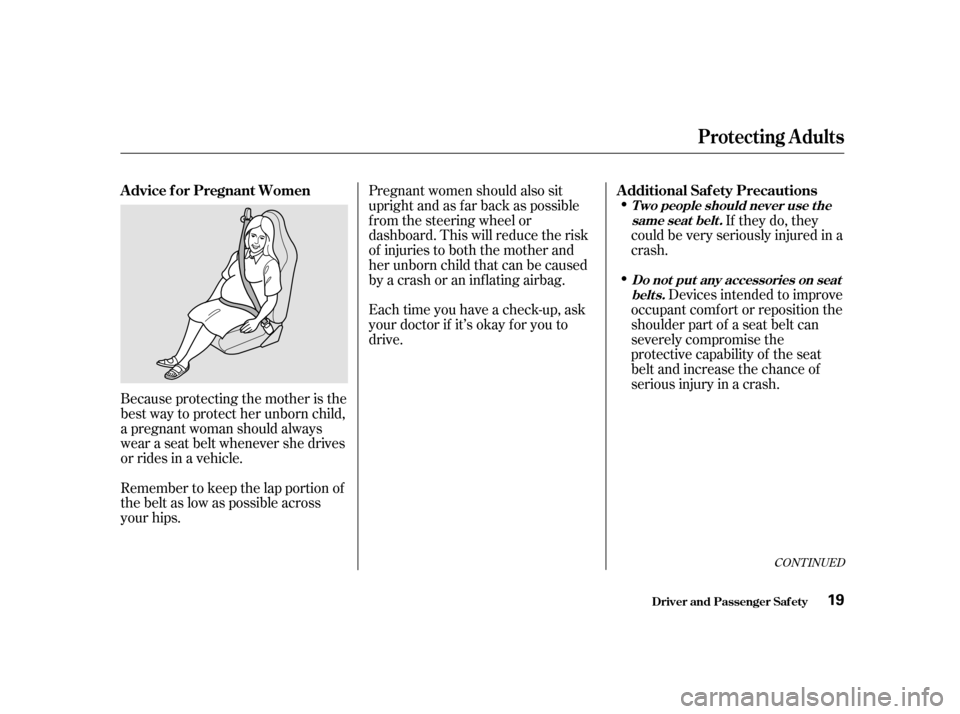
Because protecting the mother is the
best way to protect her unborn child,
a pregnant woman should always
wear a seat belt whenever she drives
or rides in a vehicle.
Remember to keep the lap portion of
the belt as low as possible across
your hips.Pregnant women should also sit
upright and as f ar back as possible
f rom the steering wheel or
dashboard. This will reduce the risk
of injuries to both the mother and
her unborn child that can be caused
by a crash or an inf lating airbag.
Each time you have a check-up, ask
your doctor if it’s okay f or you to
drive.
If they do, they
couldbeveryseriouslyinjuredina
crash.
Devices intended to improve
occupant comf ort or reposition the
shoulder part of a seat belt can
severely compromise the
protective capability of the seat
belt and increase the chance of
serious injury in a crash.
CONT INUED
Protecting Adults
Driver and Passenger Saf ety
Advice f or Pregnant Women Additional Saf ety Precautions
T wo people should never use t he
same seat belt .
Do not put any accessories on seatbelts.
19
Page 24 of 320
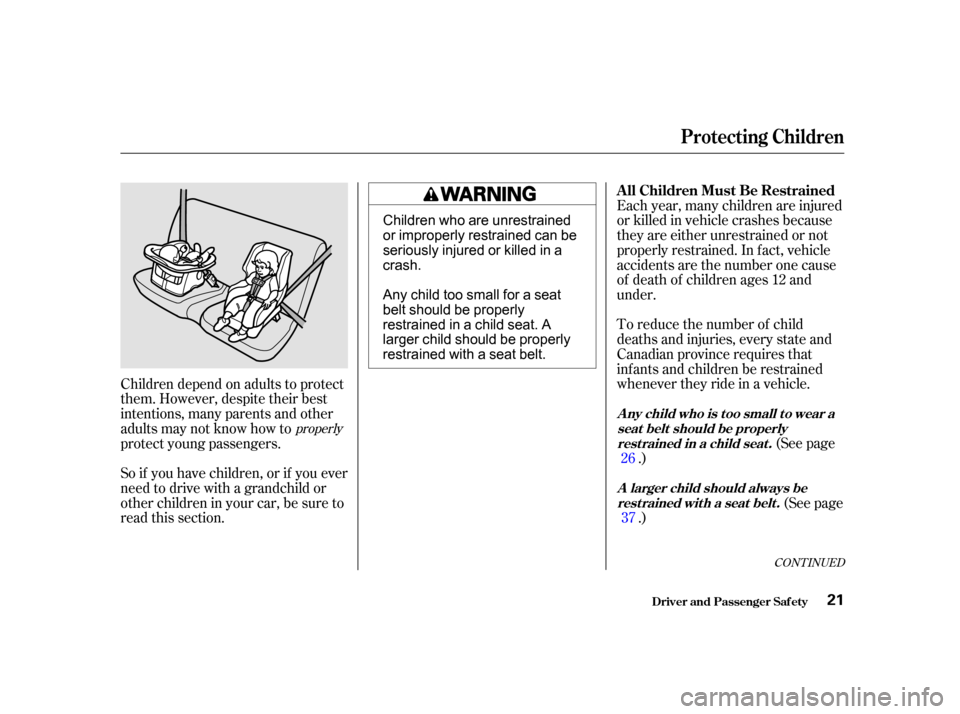
(See page
.)
To reduce the number of child
deaths and injuries, every state and
Canadian province requires that
inf ants and children be restrained
whenever they ride in a vehicle. Each year, many children are injured
or killed in vehicle crashes because
they are either unrestrained or not
properly restrained. In f act, vehicle
accidents are the number one cause
of death of children ages 12 and
under.
Children depend on adults to protect
them. However, despite their best
intentions, many parents and other
adults may not know how to
protect young passengers.
So if you have children, or if you ever
need to drive with a grandchild or
otherchildreninyourcar,besureto
read this section. (See page
.)
26
37
properly
CONT INUED
Driver and Passenger Saf ety
Protecting Children
All Children Must Be Restrained
Anychildwhoistoosmalltoweara seat belt should be properlyrest rained in a child seat .
A larger child should always berest rained wit h a seat belt .
21
Children who are unrestrained
or improperly restrained can be
seriously injured or killed in a
crash.
Any child too small for a seat
belt should be properly
restrained in a child seat. A
larger child should be properly
restrained with a seat belt.
Page 25 of 320

Front airbags have been designed to
help protect adults in a moderate to
severe f rontal collision. To do this,
the passenger’s f ront airbag is quite
large, and it inf lates with tremendous
speed.If
the airbag inf lates, it can hit the back
of the child seat with enough force
to kill or very seriously injure an
inf ant.
According to accident statistics,
children of all ages and sizes are
saf er when they are restrained in the
back seat, not the f ront seat. The
National Highway Traf f ic Saf ety
Administration and Transport
Canada recommend that all children
ages 12 and under be properly
restrained in the back seat.
In the back seat, children are less
likely to be injured by striking hard
interior parts during a collision or
hard braking. Also, children cannot
be injured by an inf lating airbag
when they ride in the back.
If you are not wearing a
seat belt in a crash, you could be
thrown f orward into the
dashboard and crush the child.
If youarewearingaseatbelt,the
child can be torn f rom your arms
during a crash. For example, if
your car crashes into a parked
vehicleat30mph(48km/h),a
20-lb (9 kg) inf ant will become a
600-lb (275 kg) f orce, and you will
not be able to hold on.
During a
crash, the belt could press deep
into the child and cause very
serious injuries.
Driver and Passenger Saf ety
Protecting Children
The Passenger’s Front Airbag
Poses Serious Risks to Children
Children Should Sit in the Back
Seat
Inf ant s
Never put a rear-f acing child seat int he f ront seat of a vehicle equippedwit h a passenger’s f ront airbag.
A ddit ional Precaut ions t o Parent s
Neverholdaninfantorchildonyour lap.
Never put a seat belt over yourselfand an inf ant or child.
22
Page 26 of 320
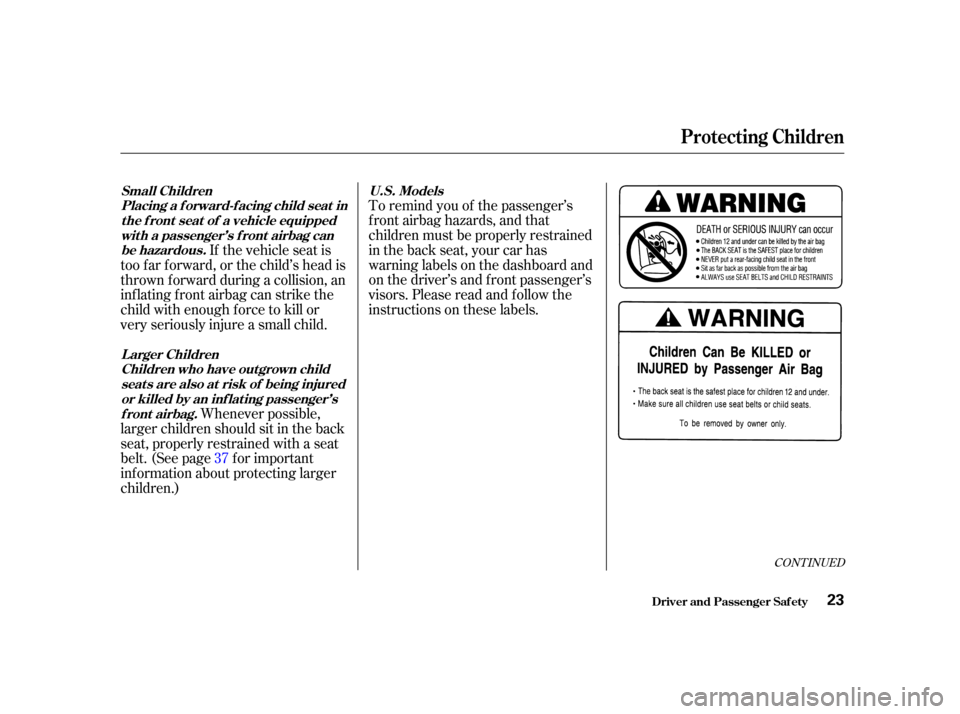
CONT INUED
To remind you of the passenger’s
f ront airbag hazards, and that
children must be properly restrained
in the back seat, your car has
warninglabelsonthedashboardand
on the driver’s and f ront passenger’s
visors. Please read and f ollow the
instructions on these labels.
Whenever possible,
larger children should sit in the back
seat, properly restrained with a seat
belt. (See page f or important
inf ormation about protecting larger
children.) If the vehicle seat is
too far forward, or the child’s head is
thrown f orward during a collision, an
inflating front airbag can strike the
child with enough f orce to kill or
very seriously injure a small child.
37
Driver and Passenger Saf ety
Protecting Children
U.S. Models
Small Children
Children who have outgrown childseat s are also at risk of being injuredor killed by an inf lat ing passenger’sfront airbag.
Placing a f orward-f acing child seat in
t he f ront seat of a vehicle equippedwit h a passenger’s f ront airbag canbe hazardous.
Larger Children
23
Page 27 of 320
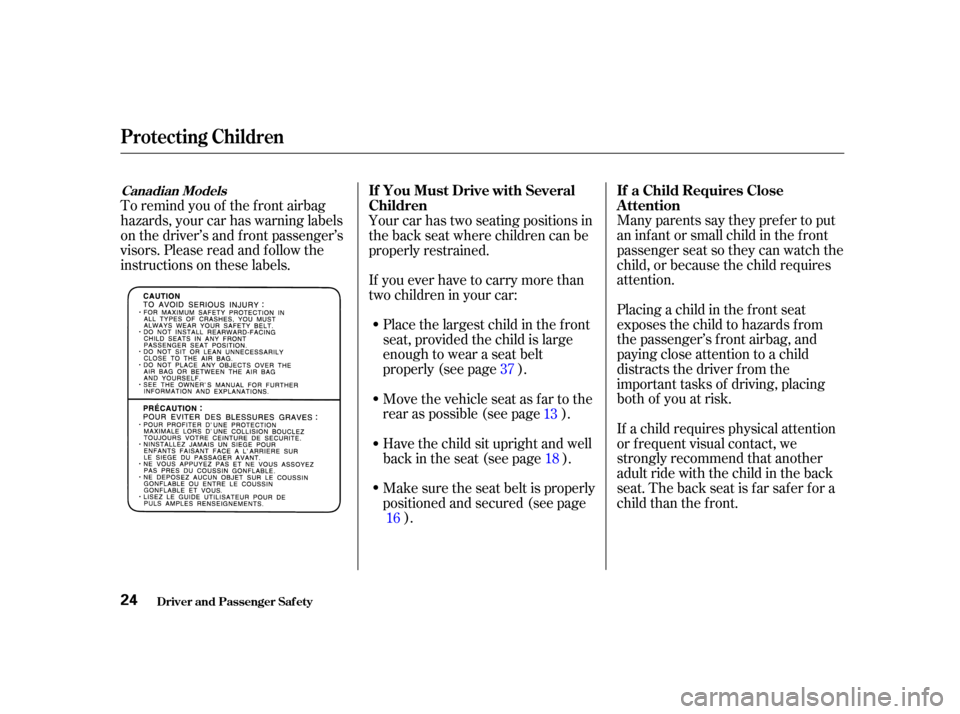
Many parents say they pref er to put
an infant or small child in the front
passenger seat so they can watch the
child, or because the child requires
attention.
Placing a child in the f ront seat
exposes the child to hazards f rom
the passenger’s f ront airbag, and
paying close attention to a child
distracts the driver f rom the
important tasks of driving, placing
both of you at risk.
If a child requires physical attention
or f requent visual contact, we
strongly recommend that another
adult ride with the child in the back
seat. The back seat is far safer for a
child than the front.
Place the largest child in the f ront
seat, provided the child is large
enough to wear a seat belt
properly (see page ).
Move the vehicle seat as far to the
rear as possible (see page ).
Have the child sit upright and well
backintheseat(seepage ).
Make sure the seat belt is properly
positioned and secured (see page
).
To remind you of the f ront airbag
hazards, your car has warning labels
on the driver’s and f ront passenger’s
visors. Please read and f ollow the
instructions on these labels.
Your car has two seating positions in
the back seat where children can be
properly restrained.
If you ever have to carry more than
twochildreninyourcar:
371318
16
Driver and Passenger Saf ety
Protecting Children
If a Child Requires Close
Attention
If You Must Drive with Several
ChildrenCanadian Models
24